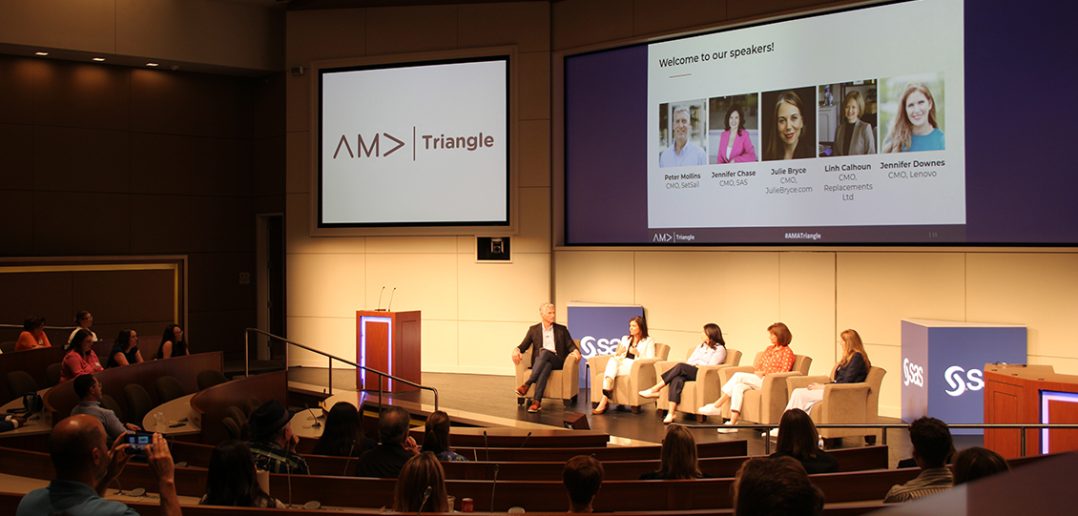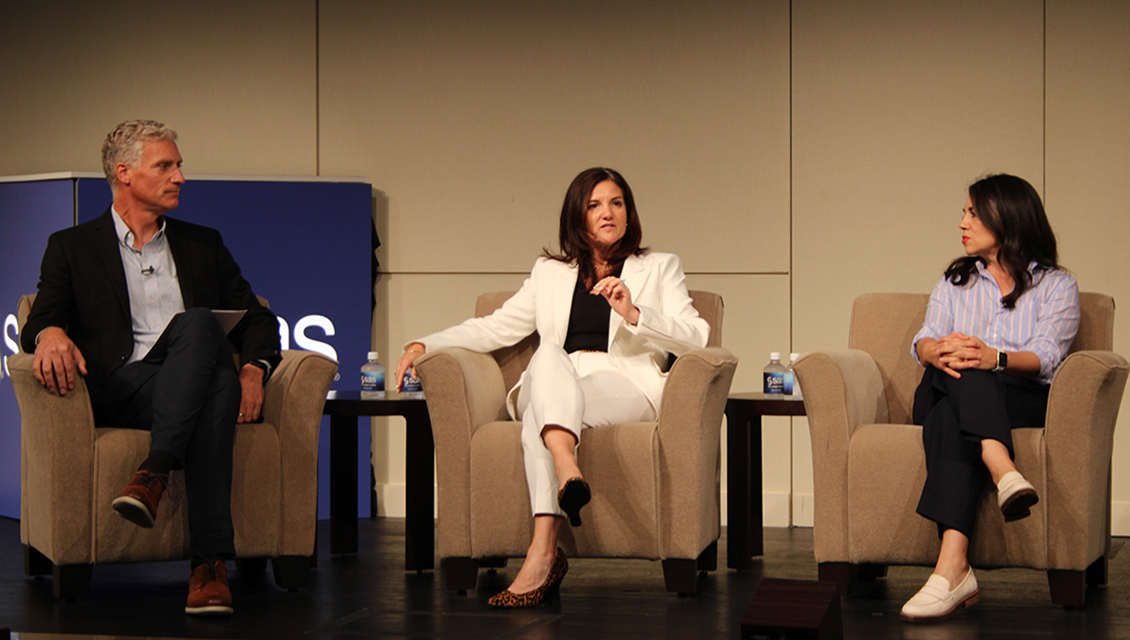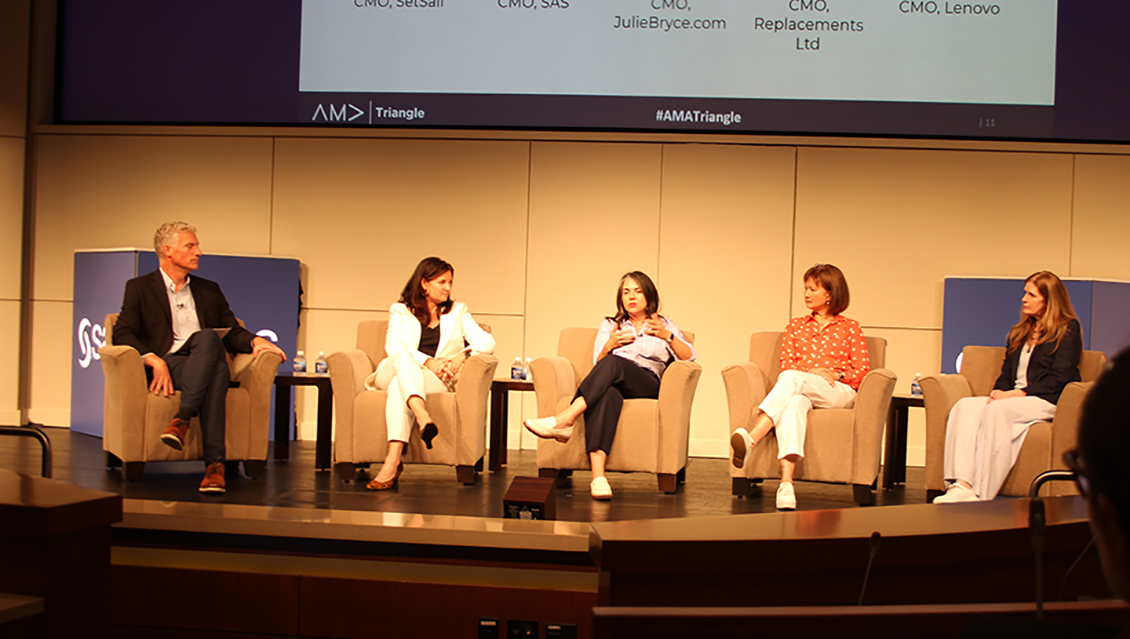SAS CMO Jennifer Chase and a panel of chief marketing officers offer insights on how they’re weaving AI into the business at American Marketing Association event
Recent Salesforce research highlights a fact that didn’t seem to surprise the full-house audience at an American Marketing Association Annual CMO panel at SAS world headquarters: AI is marketers’ top priority and biggest headache.
Peter Mollins, CMO of SetSail and moderator of the panel, invited featured leaders to share strategic ways they’re integrating AI into their businesses, from the hurdles to the heroics. Panelists included:
- Jennifer Chase, CMO, SAS.
- Julie Bryce, CMO JulieBryce.com.
- Linh Calhoun, CMO, Replacements Ltd.
- Jennifer Downes, CMO, Lenovo.
Most are actively engaged in efforts to expand content, improve campaign planning and efficiency, organize large data sets and find trends. They’re also experimenting with ways to surprise and delight their customer bases.
Generating the value
“Generative AI is becoming almost like a teammate for creativity,” said Chase. “But at SAS, we also make many of these AI-driven products, and we are ‘Customer Zero’ for our R&D teams.” She talked about putting long-form content into a SAS knowledge base – rather than a large language model – where derivative content and assets can be generated in ways that are more likely to be accurate, compelling and have the SAS tone of voice. “It’s going to improve productivity for marketers, improve our speed to market and improve the customer experience.”
Chase noted the importance of interacting with the software differently, opening the technology to a broader group of users within the organization and asking questions of the data so marketers can speak more intelligently to the data scientists.
Bryce agreed on the importance of better data access to realize AI’s full potential. “CMOs need to act more like CTOs,” she said, referring to it as “sitting at the intersection of storytelling and engineering.”
“Collaboration is so important, particularly in smaller organizations where AI can seem overwhelming,” said Calhoun. “Everyone needs to be in the conversation.” Later in the discussion, she admitted that she has never worked more closely with her Legal team than she is now.
Prompting engagement through education, data literacy
How do you get the top leadership on the AI bandwagon? It is a challenge for many organizations. “More than 71 percent of employees say they are using generative AI at work, but only about 40 percent of CEOs can say the same,” said Bryce. “Most are being led into it by their teams. But if all these people are using it to find the best cornbread recipe, why not embrace that productivity at work? It’s a bottom-up viral engagement that requires a top-down approach.”
Downes discussed the dilemma of educating customers and the community at the same time organizations are educating their workforces. That includes responsible and ethical use of AI as well as accuracy and comfort level. “It’s a serious skill upleveling and an effort to educate the team at broader scale.” Learning how to prompt, for example, will become a critical skill and one that is already starting to show up on job descriptions.
“Gone are the days that a marketer can be creative and not technical,” said Chase. She referenced SAS’ generative AI Center of Excellence, adopting AMA’s marketing capabilities as a framework for marketers, and companywide AI training as two examples of focused training.
Stay curious, but true
According to Bryce, the most important quality in pushing AI forward is intellectual curiosity. “We have to be hungry to understand how AI works,” she said. “When the prompts change or prompts are no longer needed, we still need to understand how I, as the human in the loop, do my job better to deliver better outcomes.”
AI will not replace a marketer, but a marketer who knows how to use AI will. This is a once-in-a-generation career opportunity.
—Jenn Chase
Calhoun also believes it’s important to encourage conversation, testing and trying – not just in marketing but across the organization. At Replacements, her team is experimenting with models for price optimizations and new ways of managing inventory.
“AI will not replace a marketer, but a marketer who knows how to use AI will,” said Chase. “This is a once-in-a-generation career opportunity.” To capitalize on it, she stressed the importance of turning up the dial on data literacy.
Downes said Lenovo is also looking at the next generation of the workforce, showcasing real and valid ways to help students and incoming workforces explore AI’s potential and their role in it: “How can you use it to power your dreams?”
“It’s kind of like hotel art,” said Bryce. “Most of the time, you know it when you see it.” That’s where human intervention can make all the difference when it comes to content creation and custom experiences. “Invest in beauty and excellence,” she said. “It’s going to matter that the internet has a lot of information about you.
“As a brand, you still need to be true to who you are,” said Calhoun.



